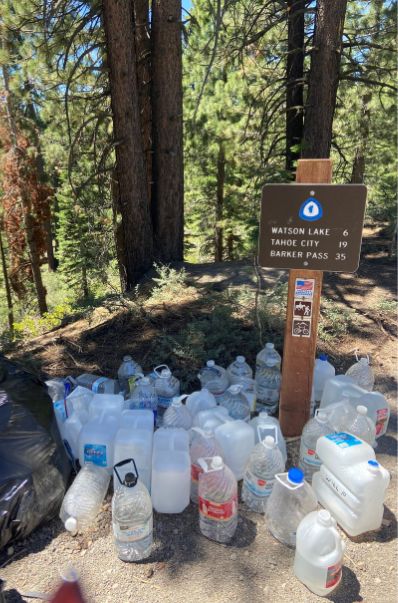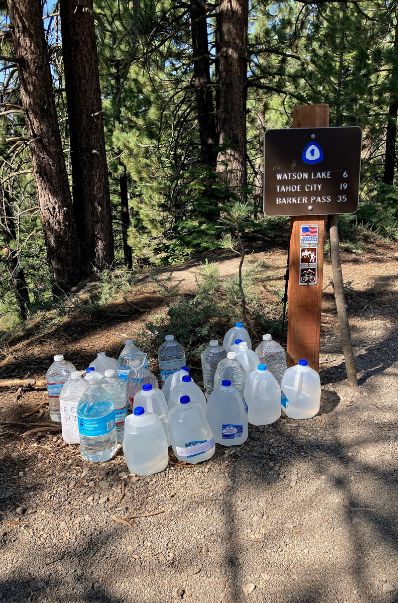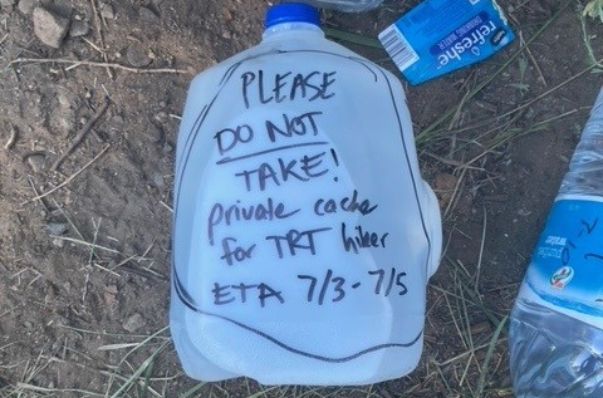Careful planning and self-reliance are not only a necessity in thru-hiking but also a part of the satisfying accomplishment of a backpacking or bike-packing trip. What should not have to be a part of any trek into the backcountry, is seeing piles of trash and plastic containers littering the trail. Water caches often cause more problems than the ones they aim to alleviate. All of these empty water bottles were placed at trailheads or along the trail with good intent, but abandonment and accumulation are a huge issue. After seeing the negative ripple effects that water caches continue to cause along the TRT, we’re motivated to make an argument for the elimination of water caches.
The TRT is a little over 173 miles in length. This number changes slightly from year to year based on reroutes, new vista points, and other small improvements annually made to the trail. As far as long-distance hiking trails go, the TRT is relatively manageable. While completing a thru-hike on the TRT is certainly no small feat, many people use it as a starting point to train for more lengthy treks like the Pacific Crest Trail or Appalachian Trail. The longest stretch of TRT a trail user will have to travel without a reliable water source is about 17 miles.
There are many downsides and dangers to water caching along a trail.

Assumptions – Can’t Cache Em’ All
Water cached in certain locations can become dangerous when hikers assume this will always be the case and prepare as though the cache is a consistent water source. This may result in trail users that are unprepared for long stretches of dry terrain. Even within a nearly 20-mile dry stretch, there are reliable water sources near the TRT that hikers can easily access by hiking a mile or so off route. It is good planning to be aware of alternative water sources that are accessible by taking short detours off of the trail. Check out our water source page and our resupply page to help plan your TRT trip.
In addition to assuming that water caches are commonplace, trail users often conclude that these are places to leave trash. Over time, other trash tends to accrue along with empty water bottles. Passersby often assume that someone must be coming to collect the plastic water bottles and will leave all kinds of waste behind at cache sites. This uncontained trash gets blown in the wind or carried off by wildlife before anyone is able to collect it. The TRTA is powered by passionate volunteers and community members, but they are not going to “Cache Em’ All” and serve as a 24/7 trash service. Trail users cannot expect trash to be cleaned up in a timely manner.
Once a Cache, Now Trash
Water caches are harmful to wildlife. Along with trash, hikers and trail angels may stash food and other vestiges of society in otherwise wilderness or protected areas. Wildlife learn that cache sites are places to patrol in search of treats. This leads to the detrimental and dangerous habituation of wild animals to humans and human food. Wildlife often consume inedible waste items which could harm or kill them. In this way, water cache sites are extremely destructive to the native fauna of the area. Since water caches are often near trailheads and parking lots, this means bears are more susceptible to breaking into cars in search of food in these locations.


Detractor of Wilderness
Water caches often negatively impact the wilderness experience many expect from the TRT. In our modern, technologically advanced world, it becomes more and more difficult to find places that are “off-grid” and away from the signs and relics of people. The increasing number of trail users has resulted in all kinds of enduring environmental repercussions, human-caused wildfires chief among them, along with the eyesores and dangers of indestructible human byproducts, aka trash!
Surrounded by the bustle of Tahoe summer, the TRT can offer solitude and relief from crowds, unless, that is, we don’t properly erase the footprints we leave in the wilderness. If you are interested in volunteering or helping hikers along the TRT, consider becoming a Task Force Trailhead Ambassador or joining a trail crew for our organization instead of leaving water for trail users. The TRTA also partners with local organizations and runs trash pick-up days at trailheads and along the trail. As you are recreating and enjoying all the outdoors has to offer, please remember that the goal as you enter the wilderness is to leave no trace of yourself behind. Whether it is a dog poop bag, a trampled area of what before was thriving vegetation, a bear that ultimately will need to be euthanized as it becomes increasingly aggressive in its pursuit of human food, a pile of smoldering coal, or a water cache, no amount of human impact in wild areas is minor. All of these actions, decisions, and oversites have repercussions that only we, as humans, have the ability to control and mitigate. A plastic water bottle is an object we are accustomed to seeing, even in nature. Are we becoming desensitized to its impact?
EXISTING SOLUTIONS
- Know before you go. That includes the risks of not packing enough water. Several reliable water sources for each segment of the TRT are detailed here.
- You can also use our interactive trail map to find reliable water sources.
- Use social media platforms like TRT-related Facebook groups to ask a trail angel or passionate community member if they’d be willing to give you a ride to a nearby community to resupply if you know the date you are expected to be at a certain trailhead location.
- If necessary, many of our major trailheads are less than 10 miles from a resupply point. Consider paying for an Uber or Taxi to restock on what you need. If you have a friend or a family member nearby, have them meet you at a trailhead with water.
- Carry water treatment systems with you.
- Many people cache water at our Spooner South Trailhead. The water at Spooner Lake is safe to drink after being treated with a filtration system and is a short distance off the trail. If necessary, Spooner Summit is a short distance from Zephyr Cove for resupply points.
Cache Sustainably
- Don’t leave your empties behind! The distance from Watson Lake to Gray Lake is about 17 miles. We understand that not everyone is able to carry enough water for such a journey. If you must cache water at Brockway Summit, we ask that you crush your plastic water jugs and take them with you as soon as you empty them. If there is water left over in the jug, please empty it and take it with you anyway.
FUTURE SOLUTIONS
The TRTA is working on investing in infrastructure to address the driest sections of the TRT. The TRTA is working with our land management agency partners to find viable solutions like putting water pumps in areas with evidence of developed campsites or putting water tanks in strategic locations that can be easily accessible via a forest service road and refilled periodically. Lastly, the TRTA is currently redesigning our major kiosks in Nevada to update panels with distances to reliable water sources so that information is more clearly labeled for trail users. This is Phase I of a larger effort to do the same at California location kiosks.



